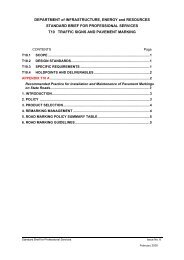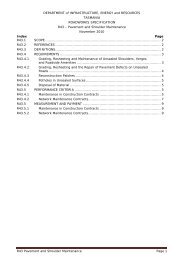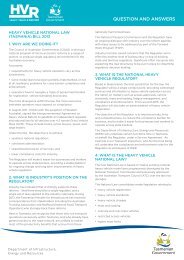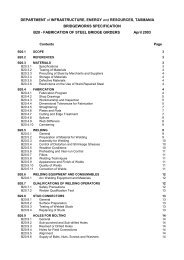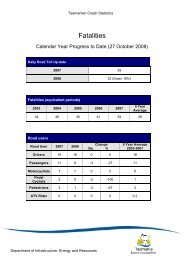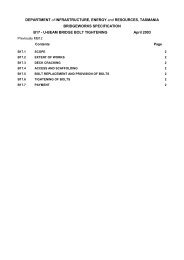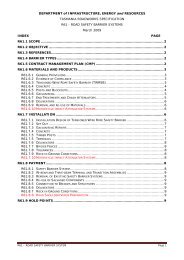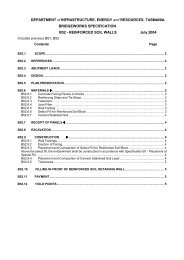Public Environment Report Tarkine Forest Drive ... - Transport
Public Environment Report Tarkine Forest Drive ... - Transport
Public Environment Report Tarkine Forest Drive ... - Transport
- No tags were found...
You also want an ePaper? Increase the reach of your titles
YUMPU automatically turns print PDFs into web optimized ePapers that Google loves.
4.10.2 Large Golden Moths (Diuris lanceolata)AbundanceThe estimated total population of large golden moths (in a good flowering year) isbetween 500 and 800 plants with 200 to 250 in each of the two largest populations atAnthony Beach and Rebecca Lagoon. There are six known populations. However, dueto agricultural activities the populations at Woolnorth and Harcus River Road are nowconsidered extinct. Because of the restricted area of suitable habitat, the populationsat Sundown Point and Nelson Bay are small (Threatened Species Unit 2000a).Distribution, ecology and habitat preferenceLarge golden moths are endemic to Tasmania and confined to a 1,220 square kilometrearea in the northwest corner of the State. Its distribution is localised in the ArthurRiver region and between Stanley and Smithton (Figure 4.5).The species is known from windswept coastal grassland and coastal scrub andheathland among dwarfed shrubs and sedges on moist to well drained sandy and clayloam, sometimes on rocky outcrops (Threatened Species Unit 2000a).Habitat occurs in the vicinity of Segment B. Observation records are shown in AppendixA Maps 5 & 6.Flowering may occur from November to January (Wapstra et al. 2010).Known threatsThe key threats to large golden moths are clearing, draining and pasture development,which is believed to have eliminated the species from much of its historicaldistribution. The sites at Sundown Point and Nelson Bay are not subject to any knownthreats (Threatened Species Unit 2000a).No threats to this species will be derived from this action as no populations occur inthe immediate vicinity of the road to be affected by any clearing or drainage works. Nopasture development is facilitated by this action.None of the other known threats will be affected by the proposed action. No clearanceof vegetation or draining is anticipated in potential habitat. No pasture developmentwill result from this action.There are no known pests or diseases that impact on this species. Neither thepreferred grassy habitat nor the species is susceptible to Phytophthora cinnamomi. Fireoutbreaks are not likely to adversely affect this species as the habitat is unlikely to beflammable during the spring flowering period. Orchids are adapted to fire and typicallybenefit from periodic burns. Fire is used as a tool for habitat management (ThreatenedSpecies Section 2010).SurveyThree of the four Natural Values Atlas records are located between Sundown Creek andNelson River and out toward Sundown Point. Targeted surveys by ECOtas (2009) in thesummer of 2008/2009 located extant populations near Sundown Point and nearRebecca Lagoon. The records from ECOtas (2009) include numerous individual plantsand localised patches that infill the known extent of this species (NBES 2011).The roadsides in the vicinity of these populations were targeted for survey (as outlinedin section 4.9.2).Ref: HB09080H001 PER <strong>Tarkine</strong> <strong>Drive</strong> 33P Rev 00/DL/CL/jw 52



